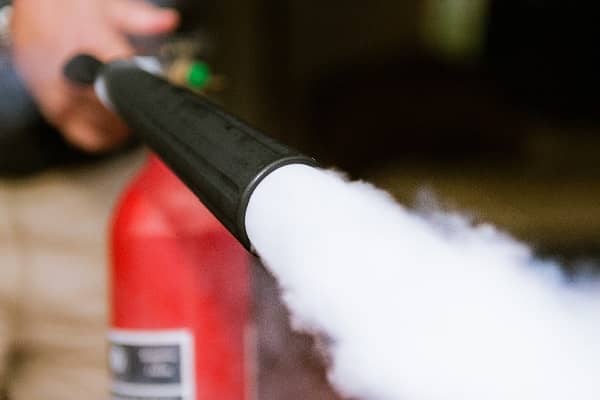Class K fire extinguishers

Understanding the proper application for a Class K extinguisher
Most people are familiar with “ABC” extinguishers. These extinguishers have proven to be very effective in extinguishing paper / wood (A), flammable liquids (B) and electrical fires (C). How- ever, they are not designed to be used for cooking fires in commercial kitchens.
Kitchen fires most often occur where cooking media (fats, greases, and oils) are used. These are most often found in commercial cooking operations.
Class K Extinguishers work on the principle of saponification. Saponification takes place when alkaline mixtures such as potassium acetate, potassium citrate, or potassium carbonate are applied to burning cooking oil of fat. The alkaline mixture combined with the fatty acid creates a soapy foam layer on the surface which holds in the vapors and steam and extinguisher the fire.
Recent changes to commercial cooking operations have presented major challenges to dry chemical fire extinguishers and systems. Changes in frying oils from animal fats to vegetable oils have reduced the ability of dry chemicals to extinguish many kitchen fires.
Since vegetable oils have lower fatty acid content, many vegetable oils will prevent the “foam blanket” from developing completely. This inhibits the extinguishing agent by allowing vapors and steam to release.
In addition, newer efficient fryers retain heat much longer than in the past. Vegetable oils have a much higher auto-ignition temperature than animal fats. Therefore, dry chemical agents have trouble preventing a reflash from occurring and cannot pass the current test standards for fryers because of the retained heat. Heat breaks down the weaker foam layer created, making it necessary to cool the oils in addition to the foam layer.
To address these issues, wet chemical agents were introduced and are now required in all new Type I hood fixed fire suppression systems. (ANSUL systems for example).
These agents are alkaline by nature and are the only extinguishing agents listed for suppression of fires in commercial cooking because of their ability to maintain the foamy layer enough to allow complete cooling. In addition, these wet chemical agents pose minimal damage threat to hot appliances.
Only the class K fire extinguisher is compatible with the wet chemical agents. The use of a multi-purpose ABC extinguisher threatens the foamy layer and cooling ability of the wet chemical agent, and consequently can result in damage to cooking appliances.
Fire extinguishers are placed in relation to the hazards they are to protect. Every commercial kitchen should have a Class K extinguisher to supplement the suppression system.
Highlights:
- Recent changes to commercial cooking operations have present- ed major challenges to dry chemical fire extinguishers and systems.
- Wet chemical commercial hood suppression systems have proven to be the most effective method of extinguishing commercial cooking fires.
- Only the Class K Fire Extinguisher is compatible with wet chemical agents.
- Every commercial kitchen should have a Class K extinguisher to supplement the suppression system.
- The use of a multi-purpose ABC extinguisher may prove ineffective to extinguish a kitchen fire and can also result in damage to cooking equipment.

This "document” is intended for general information purposes and should not be construed as advice or opinions on any specific facts or circumstances. The content of this document is made available on an “as is” basis, without warranty of any kind. This document cannot be assumed to contain every acceptable safety and compliance procedure or that additional procedures might not be appropriate under the circumstances. Markel does not guarantee that this information is or can be relied on for compliance with any law or regulation, assurance against preventable losses, or freedom from legal liability. This publication is not intended to be legal, underwriting, or any other type of professional or technical advice. Persons requiring advice should consult an independent adviser or trained professional. Markel does not guarantee any particular outcome and makes no commitment to update any information herein, or remove any items that are no longer accurate or complete. Furthermore, Markel does not assume any liability to any person or organization for loss or damage caused by or resulting from any reliance placed on this content.
Markel® is a registered trademark of Markel Group Inc.
© 2023 Markel Service, Incorporated. All rights reserved.
Tags
